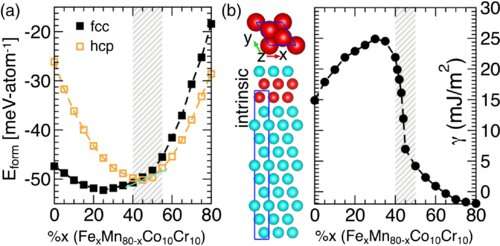Computational discovery of complex alloys could speed the way to green aviation

Computational materials science experts at the U.S. Department of Energy's Ames Laboratory and their collaborators have identified the source of and the way to tune the strength and ductility of a class of materials called high-entropy alloys. The discovery may help power-generation and aviation industry develop more efficient engines, reducing fuel consumption and carbon emissions.
High-entropy alloys are composed from four or more different elements, and often have many desirable properties— they are lightweight, strong, ductile, corrosion resistant and ideal for energy-generation applications in extreme environments, like aviation. But, because the elements that make up an alloy can vary, as well as their relative proportions, experimentally testing the sheer number of possible combinations and their properties is difficult and time-consuming.
The Ames Laboratory-led team used a quantum-mechanical modeling method to computationally discover and predict the atomic structure of a particularly promising HEA system, FexMn80−xCo10Cr10, and how transformations and defects in that structure result in a stronger, more ductile material.
"When we can pinpoint these transformations and the effect they have on a material's properties, we can predict the strength of it, and we can deliberately design strength and ductility into these very complex alloys," said Ames Laboratory scientist Duane Johnson. These predictions were then confirmed experimentally, studying single-crystal samples with advanced electron microscopy, including selective-area and electron-backscattered diffraction. Notably, the method is applicable to any multi-element complex alloy.
Theory-guided computational design, Johnson said, holds great promise for optimizing the performance of these materials, making them stronger, more ductile, and in many cases, less expensive. These performance improvements could have big implications for applications in extreme environments, like turbine engines for power-generation or aviation, which work more efficiently at higher temperatures.
"Using this predictive method, we've been able to speed up our alloy development timeline by more than 50%, and demonstrate 10–20% higher operational temperatures," said Johnson. In the case of aviation, he said, this could translate into hundreds of millions of dollars in cost savings, and a significant reduction in greenhouse emissions.
The research is further discussed in the paper "Martensitic Transformation in FexMn80−xCo10Cr10 High-Entropy Alloy," authored by P. Singh, S. Picak, A. Sharma, Y. I. Chumlyakov, R. Arroyave, I. Karaman, and Duane D. Johnson; and published in Physical Review Letters.
More information: P. Singh et al, Martensitic Transformation in FexMn80−xCo10Cr10 High-Entropy Alloy, Physical Review Letters (2021). DOI: 10.1103/PhysRevLett.127.115704
Journal information: Physical Review Letters
Provided by Ames Laboratory





















